Spatially Illustrating Leisure Agriculture: Empirical Evidence from Picking Orchards in China
Abstract
1. Introduction
2. Methodology
2.1. Data Resources
2.2. Methods
2.2.1. Average Nearest Neighbor (ANN)
2.2.2. Multi-Distance Spatial Cluster Analysis (Ripley’s L Functions)
2.2.3. Kernel Density Estimation (KDE)
2.2.4. Lorenz Curve and Gini Coefficient
3. Results
3.1. Spatial Pattern of Picking Orchards
3.1.1. Spatial Distribution of Picking Orchards in China
3.1.2. Interprovincial Discrepancy of Picking Orchard Distribution
3.2. The Influencing Factors of Picking Orchard Spatial Pattern
3.2.1. Topographic and Geomorphic Conditions
3.2.2. Distance to City Centers
3.2.3. Economic Factors
3.2.4. Traffic Condition
3.2.5. Tourism Resources
4. Discussion
4.1. Research Findings Compared to Other Studies
4.2. Research Limitations
4.3. Practical Implications
5. Conclusions
Author Contributions
Funding
Conflicts of Interest
Appendix A
| Provincial-Level District | Area (/1000 km2) | Population (/Million) | Population Density (/km2) | Orchard Number | Orchard Density (/Million People) | Orchard Density (/1000 km2) |
|---|---|---|---|---|---|---|
| Beijing | 16.40 | 21.54 | 1313.05 | 2552 | 118.48 | 15.56 |
| Shandong | 155.85 | 100.47 | 644.67 | 2117 | 21.07 | 1.36 |
| Jiangsu | 102.59 | 80.51 | 784.75 | 1851 | 22.99 | 1.80 |
| Henan | 165.65 | 96.05 | 579.83 | 1540 | 16.03 | 0.93 |
| Zhejiang | 105.05 | 57.37 | 546.10 | 1332 | 23.22 | 1.27 |
| Hebei | 188.17 | 75.56 | 401.55 | 1235 | 16.34 | 0.66 |
| Sichuan | 486.11 | 83.41 | 171.59 | 1156 | 13.86 | 0.24 |
| Guangdong | 177.93 | 113.46 | 637.67 | 1040 | 9.17 | 0.59 |
| Anhui | 140.14 | 63.24 | 451.27 | 892 | 14.10 | 0.64 |
| Shanghai | 8.06 | 24.24 | 3008.00 | 844 | 34.82 | 10.47 |
| Liaoning | 146.78 | 43.59 | 296.97 | 807 | 18.51 | 0.55 |
| Hubei | 185.94 | 59.17 | 318.22 | 636 | 10.75 | 0.34 |
| Hunan | 211.83 | 68.99 | 325.68 | 550 | 7.97 | 0.26 |
| Shaanxi | 205.55 | 38.64 | 187.98 | 517 | 13.38 | 0.25 |
| Chongqing | 82.37 | 31.02 | 376.59 | 430 | 13.86 | 0.52 |
| Yunnan | 383.22 | 48.3 | 126.04 | 397 | 8.22 | 0.10 |
| Jiangxi | 166.94 | 46.48 | 278.42 | 393 | 8.46 | 0.24 |
| Shanxi | 156.75 | 37.18 | 237.19 | 313 | 8.42 | 0.20 |
| Guizhou | 176.09 | 36 | 204.44 | 303 | 8.42 | 0.17 |
| Jilin | 191.02 | 27.04 | 141.56 | 275 | 10.17 | 0.14 |
| Tianjin | 11.79 | 15.6 | 1322.94 | 260 | 16.67 | 2.21 |
| Inner Mongolia | 1146.14 | 25.34 | 22.11 | 242 | 9.55 | 0.02 |
| Guangxi | 236.57 | 49.26 | 208.22 | 216 | 4.38 | 0.09 |
| Xinjiang | 1630.59 | 24.87 | 15.25 | 206 | 8.28 | 0.01 |
| Fujian | 122.33 | 39.41 | 322.17 | 199 | 5.05 | 0.16 |
| Heilongjiang | 452.73 | 37.73 | 83.34 | 173 | 4.59 | 0.039 |
| Gansu | 425.43 | 26.37 | 61.98 | 147 | 5.57 | 0.04 |
| Ningxia | 51.96 | 6.88 | 132.41 | 58 | 8.43 | 0.11 |
| Hainan | 33.98 | 9.34 | 274.89 | 56 | 6.00 | 0.17 |
| Qinghai | 696.66 | 6.03 | 8.66 | 27 | 4.48 | 0.004 |
| Tibet | 1202.08 | 3.44 | 2.86 | 14 | 4.07 | 0.001 |
Appendix B
References
- Veal, A.J. The leisure society II: The era of critique, 1980–2011. World Leis. J. 2012, 54, 99–140. [Google Scholar] [CrossRef]
- Molitor, G. The Dawn of the Leisure Era. Assoc. Manag. 2000, 52, 76–81. [Google Scholar]
- Molitor, G.T.T.; Forecasting, P.P. Part I: Oncoming “Leisure Era”: How We are Getting There. J. Futures Stud. 2008, 12, 109–120. [Google Scholar]
- Liu, Y.; Jing, Y.; Cai, E.; Cui, J.; Zhang, Y.; Chen, Y. How Leisure Venues Are and Why? A Geospatial Perspective in Wuhan, Central China. Sustainability 2017, 9, 1865. [Google Scholar] [CrossRef]
- Jing, Y.; Liu, Y.; Cai, E.; Liu, Y.; Zhang, Y. Quantifying the spatiality of urban leisure venues in Wuhan, Central China—GIS-based spatial pattern metrics. Sustain. Cities Soc. 2018, 40, 638–647. [Google Scholar] [CrossRef]
- United Nations. World Urbanization Prospects: The 2018 Revision; United Nations: New York, NY, USA, 2019. [Google Scholar]
- Tian, F.; Pan, J. Hospital bed supply and inequality as determinants of maternal mortality in China between 2004 and 2016. Int. J. Equity Health 2021, 20, 51. [Google Scholar] [CrossRef] [PubMed]
- Chen, M.; Zhang, J.; Zhang, Y.; Wu, K.; Yang, Y. Rural Soundscape: Acoustic Rurality? Evidence from Chinese Countryside. Prof. Geogr. 2021, 1–14, published online. [Google Scholar] [CrossRef]
- Yarwood, R. Beyond the Rural Idyll: Images, countryside change and geography. Geography 2020, 90, 19–31. [Google Scholar] [CrossRef]
- Daugstad, K.; Kirchengast, C. Authenticity and the Pseudo-Backstage of Agri-Tourism. Ann. Tour. Res. 2013, 43, 170–191. [Google Scholar] [CrossRef]
- Flanigan, S.; Blackstock, K.; Hunter, C. Generating public and private benefits through understanding what drives different types of agritourism. J. Rural Stud. 2015, 41, 129–141. [Google Scholar] [CrossRef]
- Zhou, L. Online rural destination images: Tourism and rurality. J. Destin. Mark. Manag. 2014, 3, 227–240. [Google Scholar] [CrossRef]
- Eusébio, C.; Carneiro, M.J.; Kastenholz, E.; Figueiredo, E.; Soares da Silva, D. Who is consuming the countryside? An activity-based segmentation analysis of the domestic rural tourism market in Portugal. J. Hosp. Tour. Manag. 2017, 31, 197–210. [Google Scholar] [CrossRef]
- Huber, M.; Hofstetter, P.; Hochuli, A. A Demand-driven Success Factor Analysis for Agritourism in Switzerland. J. Rural Community Dev. 2020, 15, 1–16. [Google Scholar]
- Chueh, H.-C.; Lu, Y.-H. My dream life in a rural world: A nonfiction media representation of rural idyll in Taiwan. J. Rural Stud. 2018, 59, 132–141. [Google Scholar] [CrossRef]
- Shucksmith, M. Re-imagining the rural: From rural idyll to Good Countryside. J. Rural Stud. 2018, 59, 163–172. [Google Scholar] [CrossRef]
- Ezebilo, E.E.; Boman, M.; Mattsson, L.; Lindhagen, A.; Mbongo, W. Preferences and willingness to pay for close to home nature for outdoor recreation in Sweden. J. Environ. Plan. Manag. 2013, 58, 283–296. [Google Scholar] [CrossRef]
- Tew, C.; Barbieri, C. The perceived benefits of agritourism: The provider’s perspective. Tour. Manag. 2012, 33, 215–224. [Google Scholar] [CrossRef]
- Haller, A. Urbanites, smallholders, and the quest for empathy: Prospects for collaborative planning in the periurban Shullcas Valley, Peru. Landsc. Urban Plan. 2017, 165, 220–230. [Google Scholar] [CrossRef][Green Version]
- Siderelis, C.; Smith, J.W. Ecological settings and state economies as factor inputs in the provision of outdoor recreation. Environ. Manag. 2013, 52, 699–711. [Google Scholar] [CrossRef]
- Bowen, R.L.; Cox, L.J.; Fox, M. The interface between tourism and agriculture. J. Tour. Stud. 1991, 2, 43–54. [Google Scholar]
- Frederick, M. Rural Tourism and Economic Development. Econ. Dev. Q. 1993, 7, 215–224. [Google Scholar] [CrossRef]
- Loumou, A.; Glourga, C.; Dimitrakopoulos, P. Tourism Contribution to Agro-Ecosystems Conservation: The Case of Lesbos Island, Greece. Environ. Manag. 2000, 26, 363–370. [Google Scholar] [CrossRef] [PubMed]
- Yang, Z.; Cai, J.; Sliuzas, R. Agro-tourism enterprises as a form of multi-functional urban agriculture for peri-urban development in China. Habitat Int. 2010, 34, 374–385. [Google Scholar] [CrossRef]
- Shih, H.-Y.; Yao, Y.-S. Indicators of Low-Carbon Management in the Leisure Industry: Research Using Examples in Taiwan and China. Sustainability 2020, 12, 4326. [Google Scholar] [CrossRef]
- Berry, H.L. ‘Crowded suburbs’ and ‘killer cities’: A brief review of the relationship between urban environments and mental health. N. S. W. Public Health Bull. 2007, 18, 222–227. [Google Scholar] [CrossRef] [PubMed]
- Wang, R.; Xue, D.; Liu, Y.; Chen, H.; Qiu, Y. The relationship between urbanization and depression in China: The mediating role of neighborhood social capital. Int. J. Equity Health 2018, 17, 105. [Google Scholar] [CrossRef] [PubMed]
- Wang, R.; Feng, Z.; Liu, Y.; Qiu, Y. Is lifestyle a bridge between urbanization and overweight in China? Cities 2020, 99, 102616. [Google Scholar] [CrossRef]
- Chen, J.; Chen, S. Mental health effects of perceived living environment and neighborhood safety in urbanizing China. Habitat Int. 2015, 46, 101–110. [Google Scholar] [CrossRef]
- Joung, D.; Lee, B.; Lee, J.; Lee, C.; Koo, S.; Park, C.; Kim, S.; Kagawa, T.; Park, B.J. Measures to Promote Rural Healthcare Tourism with a Scientific Evidence-Based Approach. Int. J. Environ. Res. Public Health 2020, 17, 3266. [Google Scholar] [CrossRef]
- Pope, D.; Tisdall, R.; Middleton, J.; Verma, A.; van Ameijden, E.; Birt, C.; Macherianakis, A.; Bruce, N.G. Quality of and access to green space in relation to psychological distress: Results from a population-based cross-sectional study as part of the EURO-URHIS 2 project. Eur. J. Public Health 2018, 28, 35–38. [Google Scholar] [CrossRef]
- Rugel, E.J.; Carpiano, R.M.; Henderson, S.B.; Brauer, M. Exposure to natural space, sense of community belonging, and adverse mental health outcomes across an urban region. Environ. Res. 2019, 171, 365–377. [Google Scholar] [CrossRef]
- Ciolac, R.; Adamov, T.; Iancu, T.; Popescu, G.; Lile, R.; Rujescu, C.; Marin, D. Agritourism-A Sustainable Development Factor for Improving the ‘Health’ of Rural Settlements. Case Study Apuseni Mountains Area. Sustainability 2019, 11, 1467. [Google Scholar] [CrossRef]
- Chiodo, E.; Fantini, A.; Dickes, L.; Arogundade, T.; Lamie, R.D.; Assing, L.; Stewart, C.; Salvatore, R. Agritourism in Mountainous Regions—Insights from an International Perspective. Sustainability 2019, 11, 3715. [Google Scholar] [CrossRef]
- Braun, T.; Dierkes, P. Connecting students to nature—How intensity of nature experience and student age influence the success of outdoor education programs. Environ. Educ. Res. 2016, 23, 937–949. [Google Scholar] [CrossRef]
- Karampela, S.; Kizos, T. Agritourism and local development: Evidence from two case studies in Greece. Int. J. Tour. Res. 2018, 20, 566–577. [Google Scholar] [CrossRef]
- Gil Arroyo, C.; Barbieri, C.; Rozier Rich, S. Defining agritourism: A comparative study of stakeholders’ perceptions in Missouri and North Carolina. Touri. Manag. 2013, 37, 39–47. [Google Scholar] [CrossRef]
- Barbieri, C.; Xu, S.; Gil-Arroyo, C.; Rich, S.R. Agritourism, Farm Visit, or …? A Branding Assessment for Recreation on Farms. J. Travel Res. 2015, 55, 1094–1108. [Google Scholar] [CrossRef]
- Gao, J.; Barbieri, C.; Valdivia, C. Agricultural Landscape Preferences: Implications for Agritourism Development. J. Travel Res. 2013, 53, 366–379. [Google Scholar] [CrossRef]
- Liang, A.R.-D.; Hsiao, T.-Y.; Chen, D.-J.; Lin, J.-H. Agritourism: Experience design, activities, and revisit intention. Tour. Rev. 2020. ahead-of-print. [Google Scholar] [CrossRef]
- Askarpour, M.H.; Mohammadinejad, A.; Moghaddasi, R. Economics of agritourism development: An Iranian experience. Econ. J. Emerg. Mark. 2020, 12, 93–104. [Google Scholar] [CrossRef]
- Colton, J.W.; Bissix, G. Developing Agritourism in Nova Scotia: Issues and Challenges. J. Sustain. Agric. 2005, 27, 91–112. [Google Scholar] [CrossRef]
- Yang, L. Impacts and Challenges in Agritourism Development in Yunnan, China. Tour. Plan. Dev. 2012, 9, 369–381. [Google Scholar] [CrossRef]
- Hung, W.-T.; Ding, H.-Y.; Lin, S.-T. Determinants of performance for agritourism farms: An alternative approach. Curr. Issues Tour. 2016, 19, 1281–1287. [Google Scholar] [CrossRef]
- LaPan, C.; Barbieri, C. The role of agritourism in heritage preservation. Curr. Issues Tour. 2014, 17, 666–673. [Google Scholar] [CrossRef]
- Barbieri, C.; Sotomayor, S.; Aguilar, F.X. Perceived Benefits of Agricultural Lands Offering Agritourism. Tour. Plan. Dev. 2019, 16, 43–60. [Google Scholar] [CrossRef]
- Nematpour, M.; Khodadadi, M. Farm tourism as a driving force for socioeconomic development: A benefits viewpoint from Iran. Curr. Issues Tour. 2021, 24, 247–263. [Google Scholar] [CrossRef]
- Veeck, G.; Hallett, L.; Che, D.; Veeck, A. The Economic Contributions of Agricultural Tourism in Michigan. Geogr. Rev. 2016, 106, 421–440. [Google Scholar] [CrossRef]
- Quadri-Felitti, D.; Fiore, A.M. Experience economy constructs as a framework for understanding wine tourism. J. Vacat. Mark. 2012, 18, 3–15. [Google Scholar] [CrossRef]
- Arru, B.; Furesi, R.; Madau, F.A.; Pulina, P. “Value portfolio”, value creation and multifunctionality: The case study of an Italian wine agritourism farm. Aestimum 2019, 75, 163–181. [Google Scholar] [CrossRef]
- Gong, X.; Zhu, W.C.; Liu, S. The Strategy of Eco-Agriculture Economic Development along the Coast Based on Improving the Rural Eco-Tourism Environment. J. Coast. Res. 2020, 104, 652–655. [Google Scholar] [CrossRef]
- Torres, R.; Momsen, J.H. Challenges and potential for linking tourism and agriculture to achieve pro-poor tourism objectives. Psychol. Rep. 2008, 40, 3027–3028. [Google Scholar] [CrossRef]
- Amsden, B.; McEntee, J. Agrileisure: Re-imagining the relationship between agriculture, leisure, and social change. Leisure/Loisir 2011, 35, 37–48. [Google Scholar] [CrossRef]
- Farmer, J.R.; Chancellor, C.; Robinson, J.M.; West, S.; Weddell, M. Agrileisure: Farmers’ Markets, CSAs, and the Privilege in Eating Local. J. Leis. Res. 2014, 46, 313–328. [Google Scholar] [CrossRef]
- Lin, C.-N. A Fuzzy Analytic Hierarchy Process-Based Analysis of the Dynamic Sustainable Management Index in Leisure Agriculture. Sustainability 2020, 12, 5395. [Google Scholar] [CrossRef]
- Bitsani, E.; Kavoura, A. Connecting Oenological and gastronomical tourisms at the Wine Roads, Veneto, Italy, for the promotion and development of agrotourism. J. Vacat. Mark. 2012, 18, 301–312. [Google Scholar] [CrossRef]
- University of Tennessee. 2007 and 2012 Census of Agriculture Data and Direct Sales, CSAs, Value-Added Products and Agritourism for Selected Southern States and the United States; University of Tennessee: Knoxville, TN, USA, 2014. [Google Scholar]
- Annes, A.; Wright, W. ‘Creating a room of one’s own’: French farm women, agritourism and the pursuit of empowerment. Women’s Stud. Int. Forum 2015, 53, 1–11. [Google Scholar] [CrossRef]
- Barbieri, C.; Streifeneder, T. Agritourism Advances around the Globe: A Commentary from the Editors. Open Agric. 2019, 4, 712–714. [Google Scholar] [CrossRef]
- Qiu, S.R.; Fan, S.S. Recreational value estimation of suburban leisure agriculture:a case study of the Qianjiangyue agritourism farm. J. Mt. Sci. 2016, 13, 183–192. [Google Scholar] [CrossRef]
- Ma, X.; Wang, R.; Dai, M.; Ou, Y. The influence of culture on the sustainable livelihoods of households in rural tourism destinations. J. Sustain. Tour. 2021, 29, 1235–1252. [Google Scholar] [CrossRef]
- Su, Z.; Aaron, J.R.; Guan, Y.; Wang, H. Sustainable Livelihood Capital and Strategy in Rural Tourism Households: A Seasonality Perspective. Sustainability 2019, 11, 4833. [Google Scholar] [CrossRef]
- Tao, C. Development Efficiency of Leisure Agriculture Based on DEA Model in the Background of Rural Revitalization. Rev. Cercet. Interv. Soc. 2019, 67, 169–187. [Google Scholar] [CrossRef]
- Du, N.; Shao, Q.; Hu, R. Price Elasticity of Production Factors in Beijing’s Picking Gardens. Sustainability 2019, 11, 2160. [Google Scholar] [CrossRef]
- Brune, S.; Knollenberg, W.; Stevenson, K.T.; Barbieri, C. U-Pick Farms: Harvesting More than Pumpkins. J. Park Recreat. Adm. 2020, 38, 135–144. [Google Scholar] [CrossRef]
- Carpio, C.E.; Wohlgenant, M.K.; Safley, C.D. A Structural Econometric Model of Joint Consumption of Goods and Recreational Time: An Application to Pick—Your—Own Fruit. Am. J. Agric. Econ. 2008, 90, 644–657. [Google Scholar] [CrossRef]
- Liu, J.; Chen, F.; Ge, Q.; Li, Y. Climate Change and Fruit-Picking Tourism: Impact and Adaptation. Adv. Meteorol. 2016, 2016, 1–11. [Google Scholar] [CrossRef]
- Wei, X.; Hou, S.; Pan, X.; Xu, C.; Li, J.; Yu, H.; Chase, J.; Atwill, E.R.; Li, X.; Chen, K.; et al. Microbiological Contamination of Strawberries from U-Pick Farms in Guangzhou, China. Int. J. Environ. Res. Public Health 2019, 16, 4910. [Google Scholar] [CrossRef] [PubMed]
- Agehara, S.; Lin, S.-Y.; Kang, L. Strawberry Production and Markets in Taiwan: Challenges, Trends, and Outlook. Int. J. Fruit Sci. 2020, 20, S2018–S2029. [Google Scholar] [CrossRef]
- Clark, J.R. Changing Times for Eastern United States Blackberries. Horttechnology 2005, 15, 491–494. [Google Scholar] [CrossRef]
- Kim, K.-H.; Park, D.-B. Factors Influencing Rural Tourists’ Purchasing Behaviour: Four Types of Direct Farm Markets in South Korea. Tour. Econ. 2014, 20, 629–645. [Google Scholar] [CrossRef]
- Van Sandt, A.; Low, S.A.; Thilmany, D. Exploring Regional Patterns of Agritourism in the U.S.: What’s Driving Clusters of Enterprises? Agric. Resour. Econ. Rev. 2018, 47, 592–609. [Google Scholar] [CrossRef]
- Yan, X.; Yinjun, C.; Yanlin, H.; Baoxiang, Q. Spatial Distribution and Influencing Factors of Leisure Agriculture: A Case from Hebei Province. Sci. Geogr. Sin. 2019, 39, 1806–1813. [Google Scholar] [CrossRef]
- Ruilin, Y.; Huiyuan, C.; Guangping, C.; Chengliang, L. Spatial Distribution of Rural Tourism Destination and Influencing Factors in Hubei Province—A Case Study of High-Star Agritainment. Econ. Geogr. 2018, 38, 210–217. [Google Scholar] [CrossRef]
- Zhiqiang, G.; Qihuang, C.; Xiaomei, J. Study on the Spatial Distribution Characteristics of Leisure Agriculture Demonstration Sites in Jiangxi. Chin. J. Agric. Resour. Regional Plan. 2018, 39, 155–162. [Google Scholar] [CrossRef]
- Sandt, A.V.; Low, S.; Jablonski, B.B.R.; Weiler, S. Place-Based Factors and the Performance of Farm-Level Entrepreneurship: A Spatial Interaction Model of Agritourism in the U.S. Rev. Reg. Stud. 2019, 49, 428–453. [Google Scholar]
- Konečný, O. Geographical Perspectives on Agritourism in The Czech Republic. Morav. Geogr. Rep. 2014, 22, 15–23. [Google Scholar] [CrossRef][Green Version]
- Van der Merwe, J.H.; Ferreira, S.L.A.; van Niekerk, A. Resource-directed spatial planning of agritourism with GIS. S. Afr. Geogr. J. 2013, 95, 16–37. [Google Scholar] [CrossRef]
- Ohe, Y.; Ciani, A. Evaluation of Agritourism Activity in Italy: Facility Based or Local Culture Based? Tour. Econ. 2011, 17, 581–601. [Google Scholar] [CrossRef]
- Barbieri, C.; Mshenga, P.M. The Role of the Firm and Owner Characteristics on the Performance of Agritourism Farms. Sociol. Rural. 2008, 48, 166–183. [Google Scholar] [CrossRef]
- AutoNavi. AutoNavi Open Platform. 2019. Available online: https://lbs.amap.com/api/webservice/guide/api/search/ (accessed on 10 November 2019).
- Chinese Academy of Sciences. Platform of Geospatial Data Cloud. 2003. Available online: http://www.gscloud.cn/ (accessed on 6 May 2015).
- China Cartographic Publishing House. Standard Map Service System. 2019. Available online: http://bzdt.ch.mnr.gov.cn/index.html (accessed on 6 September 2019).
- National Geomatic Center of China. Metadata Catalog Service for Geographic Information Resource. 2015. Available online: https://www.webmap.cn/ (accessed on 6 September 2019).
- National Bureau of Statistics of China. China Statistical Yearbook; China Statistic Press: Beijing, China, 2019.
- Franca, R. Spatial patterns of snake diversity in an urban area of north-east Brazil. Herpetol. J. 2019, 29, 274–281. [Google Scholar] [CrossRef]
- Ebdon, D. Statistics in Geography; Wiley-Blackwell: Hoboken, NJ, USA, 1991. [Google Scholar]
- Lee, J.; Wong, D. Statistical Analysis with ArcView GIS; John Wiley & Sons: Hoboken, NJ, USA, 2000. [Google Scholar]
- Dhanaraj, K.; Angadi, D.P. A GIS based interpretation of the historical evolution of urban settlements in Mangalore City, India. Spat. Inf. Res. 2020, 1–15, published online. [Google Scholar] [CrossRef]
- Besag, J. Contribution to the discussion on Ripley’s paper. J. R. Stat. Soc. Ser. B (Methodological) 1977, 39, 193–195. [Google Scholar]
- Elliott, G.P.; Kipfmueller, K.F. Multi-scale Influences of Slope Aspect and Spatial Pattern on Ecotonal Dynamics at Upper Treeline in the Southern Rocky Mountains, U.S.A. Arct. Antarct. Alp. Res. 2018, 42, 45–56. [Google Scholar] [CrossRef]
- Ripley, B.D. The second-order analysis of stationary point processes. J. Appl. Probab. 2016, 13, 255–266. [Google Scholar] [CrossRef]
- Ripley, B.D. Modelling spatial patterns. J. R. Stat. Soc. 1977, 39, 172–192. [Google Scholar] [CrossRef]
- Hassan, M.M.; Juhász, L.; Southworth, J. Mapping Time-Space Brickfield Development Dynamics in Peri-Urban Area of Dhaka, Bangladesh. ISPRS Int. J. Geo-Inf. 2019, 8, 447. [Google Scholar] [CrossRef]
- Andresen, M.A. Testing for similarity in area-based spatial patterns: A nonparametric Monte Carlo approach. Appl. Geogr. 2009, 29, 333–345. [Google Scholar] [CrossRef]
- Metsaranta, J.M. Influence of past mortality and measurement thresholds on tree-ring inferred trends in tree distribution and size-growth relationships at a Populus tremuloides stand in the Northwest Territories, Canada. For. Ecol. Manag. 2020, 466, 118138. [Google Scholar] [CrossRef]
- Bíl, M.; Andrášik, R.; Sedoník, J. A detailed spatiotemporal analysis of traffic crash hotspots. Appl. Geogr. 2019, 107, 82–90. [Google Scholar] [CrossRef]
- Chen, Y.; Liu, X.; Li, X.; Liu, Y.; Xu, X. Mapping the fine-scale spatial pattern of housing rent in the metropolitan area by using online rental listings and ensemble learning. Appl. Geogr. 2016, 75, 200–212. [Google Scholar] [CrossRef]
- Lorenz, M.O. Methods of Measuring the Concentration of Wealth. Publ. Am. Stat. Assoc. 1905, 9, 209–219. [Google Scholar] [CrossRef]
- Gini, C.W. Variability and mutability, contribution to the study of statistical distributions and relations. Studi Economico-Giuridici della R. Universita de Cagliari (1912). J. Am. Stat. Assoc. 1971, 66, 534–544. [Google Scholar]
- Chen, Z.; Jin, F. Scope, shape, and structural characteristics of traffic circles ofequal travel time in Beijing. Prog. Geogr. 2016, 35, 389–398. [Google Scholar] [CrossRef][Green Version]
- Verhetsel, A.; Beckers, J.; De Meyere, M. Assessing Daily Urban Systems: A Heterogeneous Commuting Network Approach. Netw. Spat. Econ. 2018, 18, 633–656. [Google Scholar] [CrossRef]
- Su, B. Rural tourism in China. Tour. Manag. 2011, 32, 1438–1441. [Google Scholar] [CrossRef]
- Shen, S.; Wang, H.; Quan, Q.; Xu, J. Rurality and rural tourism development in China. Tour. Manag. Perspect. 2019, 30, 98–106. [Google Scholar] [CrossRef]
- Xue, L.; Kerstetter, D.; Hunt, C. Tourism development and changing rural identity in China. Ann.Tour. Res. 2017, 66, 170–182. [Google Scholar] [CrossRef]
- Liu, C.; Dou, X.; Li, J.; Cai, L.A. Analyzing government role in rural tourism development: An empirical investigation from China. J. Rural Stud. 2020, 79, 177–188. [Google Scholar] [CrossRef]
- Sadowski, A.; Wojcieszak, M.M. Geographic differentiation of agritourism activities in Poland vs. cultural and natural attractiveness of destinations at district level. PLoS ONE 2019, 14, e0222576. [Google Scholar] [CrossRef] [PubMed]
- Yu, W.; Spencer, D.M. Motivations, challenges, and self-transformations of farmers engaged in farm tourism on a tropical island. J. Herit. Tour. 2021, 16, 164–180. [Google Scholar] [CrossRef]
- Bagi, F.S.; Reeder, R.J. Factors affecting farmer participation in agritourism. Agric. Resour. Econ. Rev. 2012, 41, 189–199. [Google Scholar] [CrossRef]
- Shaken, A.; Mika, M.; Plokhikh, R.V. Exploring the social interest in agritourism among the urban population of Kazakhstan. Misc. Geogr. 2020, 24, 16–23. [Google Scholar] [CrossRef]
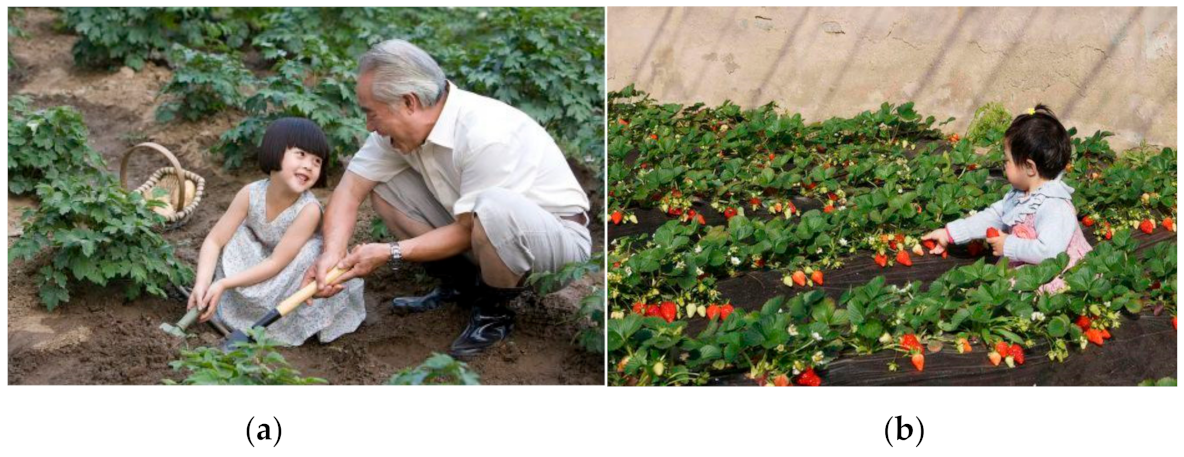
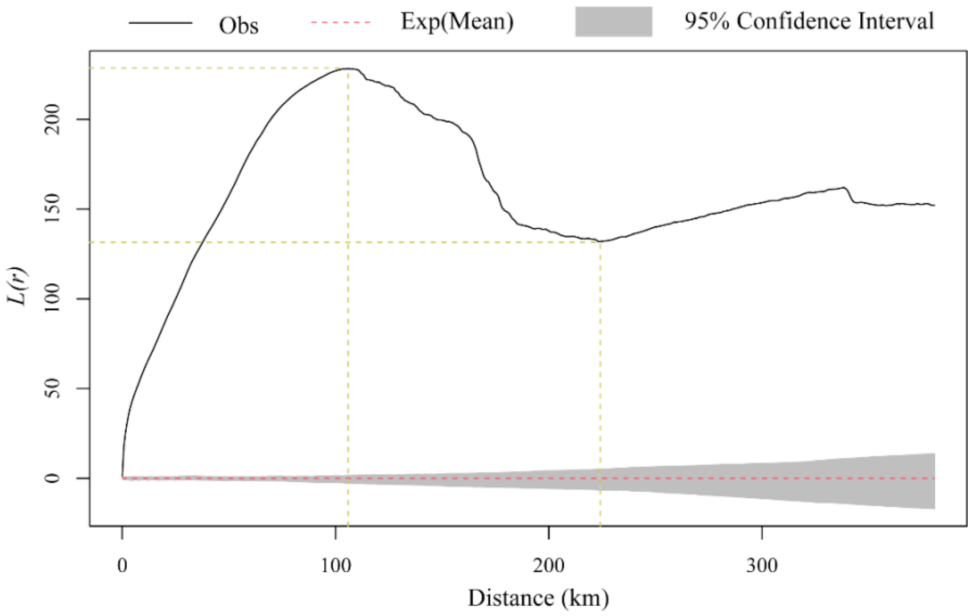

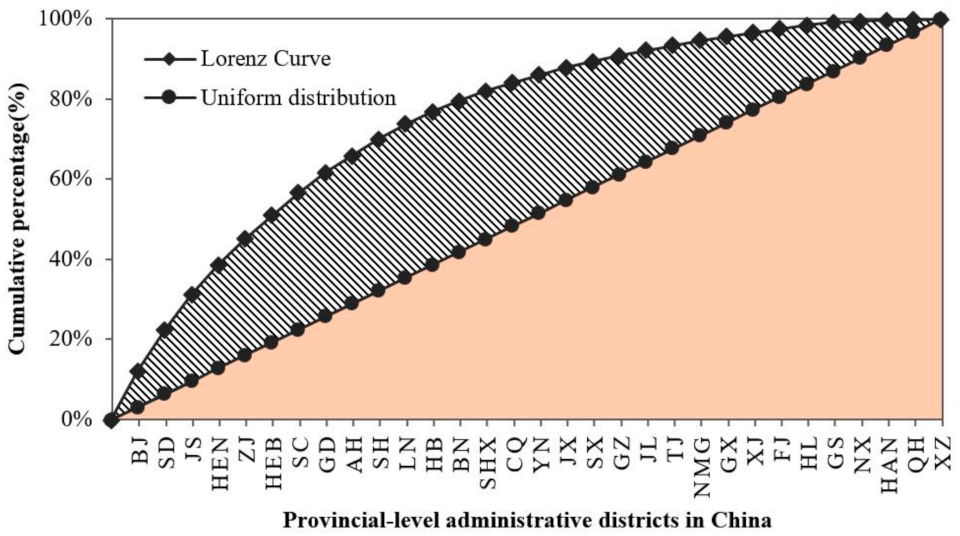
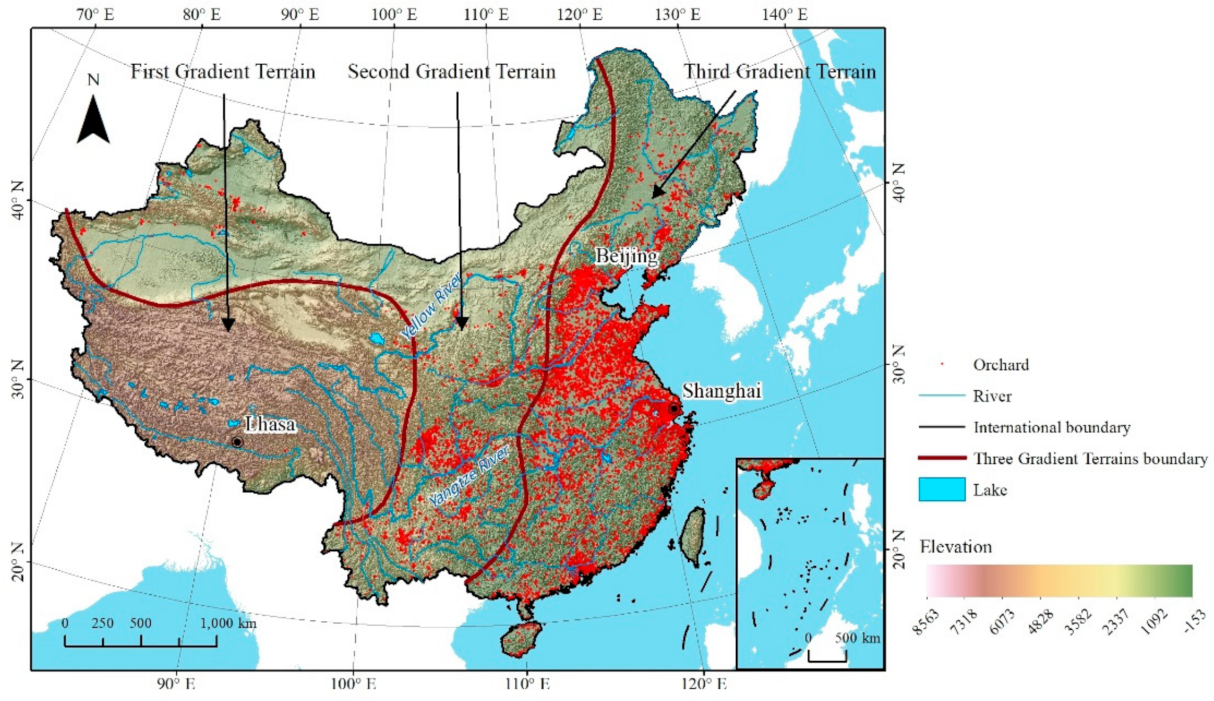
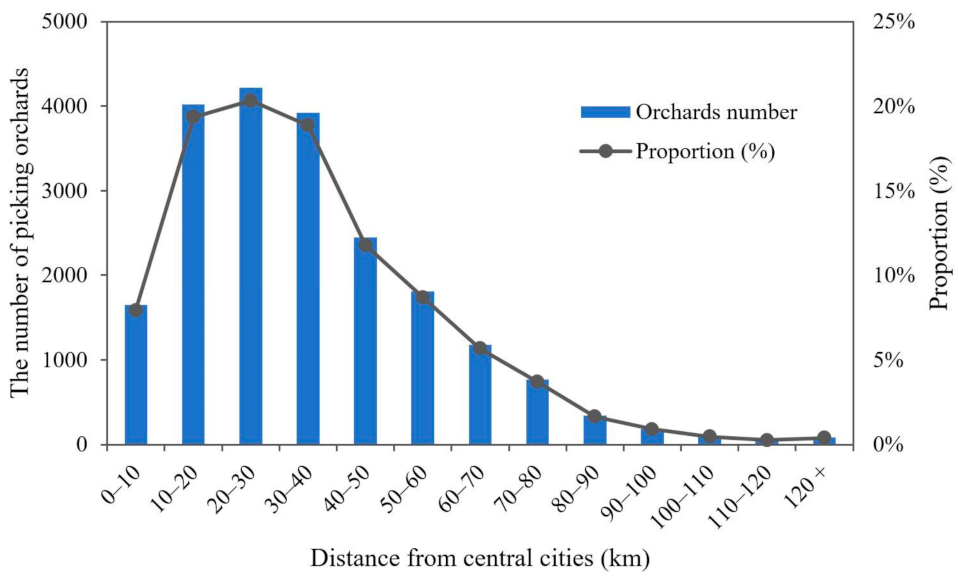
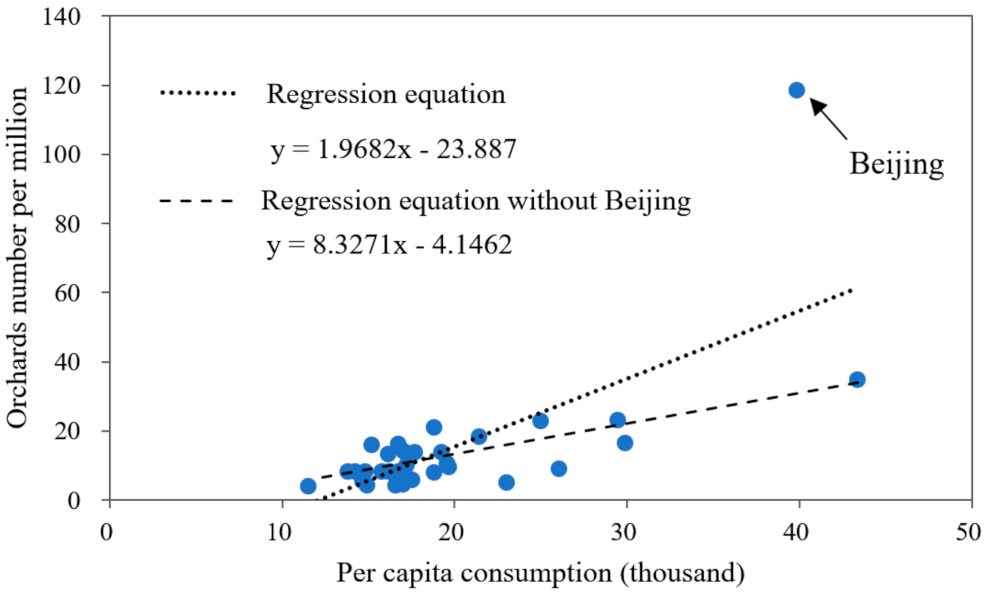
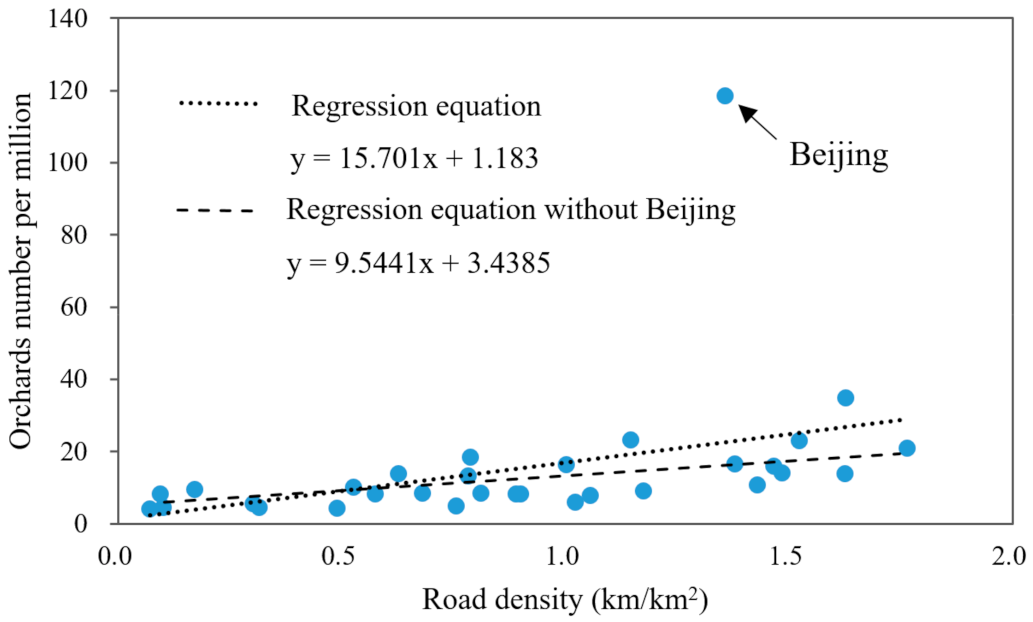

| Data Name | Data Type | Time Period | Resolution | Data Source |
|---|---|---|---|---|
| Picking orchards | Points | 2019 | - | POIs of Gaode Map [81] |
| Digital Elevation Model (DEM) | Grid | 2003 | 30 m × 30 m | Platform of Geospatial Data Cloud [82] |
| National boundary, sea land border, and major rivers | Vector | 2019 | 1:60,000,000 | Standard Map Service System [83] |
| Administrative boundary and road map | Vector | 2015 | 1:250,000 | National Geomatics Center of China [84] |
| Socioeconomic data | Txt | 2019 | County level | China Statistical Yearbook [85] |
Publisher’s Note: MDPI stays neutral with regard to jurisdictional claims in published maps and institutional affiliations. |
© 2021 by the authors. Licensee MDPI, Basel, Switzerland. This article is an open access article distributed under the terms and conditions of the Creative Commons Attribution (CC BY) license (https://creativecommons.org/licenses/by/4.0/).
Share and Cite
Cui, J.; Li, R.; Zhang, L.; Jing, Y. Spatially Illustrating Leisure Agriculture: Empirical Evidence from Picking Orchards in China. Land 2021, 10, 631. https://doi.org/10.3390/land10060631
Cui J, Li R, Zhang L, Jing Y. Spatially Illustrating Leisure Agriculture: Empirical Evidence from Picking Orchards in China. Land. 2021; 10(6):631. https://doi.org/10.3390/land10060631
Chicago/Turabian StyleCui, Jiaxing, Ruihao Li, Lingyu Zhang, and Ying Jing. 2021. "Spatially Illustrating Leisure Agriculture: Empirical Evidence from Picking Orchards in China" Land 10, no. 6: 631. https://doi.org/10.3390/land10060631
APA StyleCui, J., Li, R., Zhang, L., & Jing, Y. (2021). Spatially Illustrating Leisure Agriculture: Empirical Evidence from Picking Orchards in China. Land, 10(6), 631. https://doi.org/10.3390/land10060631








